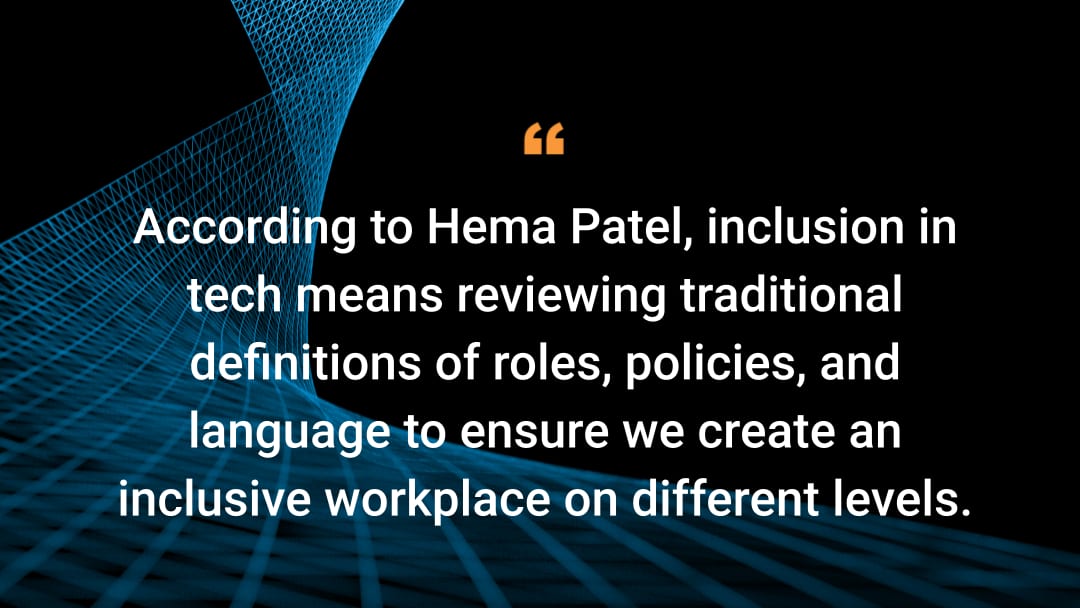Inclusion in Tech: Discover Diverse Career Paths for Women in Tech

In this blog post, the latest in the Akamai “Women in Tech” blog series, Employer Brand Manager Hema Patel discusses opportunities in tech for women without formal STEM backgrounds, how branding influenced her decision to work at Akamai, and what challenges women with families face while working in the tech industry.
Despite the contributions of women like Ada Lovelace and Grace Hopper, the tech industry continues to struggle with inclusion, particularly when it comes to funding, mentorship, and promotions for women. Some women who are interested in tech do not always have an educational background or specialized training in fields related to science, technology, engineering, and math (STEM), and these factors can play a pivotal role in why women shy away from pursuing a career in tech.
Exploring alternative routes to a career path in tech
As someone who was never interested in working in the tech industry, Hema Patel knows that there are many ways to enter the tech landscape without having a technical education in engineering or programming.
“There is still a perception around working in tech, that you have to be technical, or you have to have a super-technical background, whether that's from experience or formal education, or informal, on-the-job training,” says Hema. “When I graduated, I wanted to work for the government. Then, I ended up working for a tech company, and I actually loved it! It was never a fully technical role; I did a lot of event planning and marketing.”
Before coming to Akamai, Hema worked for two tech companies, including Microsoft, in nontechnical roles.
“There are many opportunities for nontechnical roles in the tech space,” explains Hema. “It's important for people to know there are roles that help run that business, such as finance or marketing, and other opportunities to learn or even experiment to see what is a fit for you.”
Employer branding can attract and retain talent
Being at Akamai for nearly five years, Hema realizes that brand reputation played a major role in how she landed her position here.
“I actually had a high school friend who worked for Akamai,” says Hema, “and she would always post on her social media about how much she loved working here and some of the great things that they were doing. When Akamai reached out to me, I was like, ‘Oh, I've heard of them. I know them. It seems like they're a great company to work for.’”
An important part of Hema’s job responsibilities is managing Akamai’s reputation as an employer in the tech world. In her current role as employer brand manager, Hema works with different stakeholders, internal teams, and outside partnerships to ensure that Akamai presents itself as a great place to work — including underrepresented communities such as women in tech.
Managing internal and external communications
Hema’s job responsibilities also include knowing what people think about Akamai, how Akamai is represented on a global scale, and how Akamai connects with potential employees.
“I manage a lot of our communications, whether it's internal communications, like with our brand ambassadors, who are very passionate about what they do and why they love working at Akamai, and how they can help; or external communications,” explains Hema. “We highlight many Akamai women, and give them various opportunities to share their story, and create a community of women that motivate other women to get involved in tech.”
Hema continues, “We highlight various aspects of life at Akamai including different career paths, benefits, flexibility, and wellness to inspire more women to join the tech space and consider Akamai as a place they can build their career. When people go to Akamai’s Glassdoor page or go to our social media channels and hear from our employees about their experiences and journey at Akamai, that is the content that my team manages.”
Workplace culture at Akamai makes employees feel welcome
Candidates not only want good pay, great benefits, and worthwhile perks, but they also want to work for organizations that respect them, regardless of their position within the organization, social class, preferred gender, race, or religion. From senior-level management to contract employees, at Akamai, Hema says, everyone is made to feel welcome.
“At Akamai, it's the people. I love my team, and all the people that I've worked with and come across throughout the company. There's a humbleness and approachability to the type of people at Akamai. We are all a team and everyone wants to help each other. It truly does make this a great place to work.
“Inclusion at Akamai is giving everyone the same opportunity. I could go into a meeting with my own team, or I could be invited to another team meeting, and I have an opportunity to ask questions, to talk and give my opinion, and not have a certain perception about me,” says Hema.

Inclusion is more than a buzzword
In the last few years, many companies have decided to put diversity, equity, and inclusion (DEI) at the forefront of workplace culture, and it is creating a global shift in which employers think about cultivating a more balanced workforce. What does inclusion look like in the tech industry?
Inclusion, diversity, and engagement (ID&E) is a major part of the Akamai brand. Hema’s team is responsible for cultivating a culture of belonging, trust, and transparency through global Employee Resource Groups, training and educational materials, and close partnerships with business leaders throughout the company.
From removing biased languages on both consumer-facing and employee-related communications to being considerate of global time zones and cultural social cues when it comes to humor and recognizing holidays, Akamai seeks to create a welcoming environment for all their employees.
Actions in addition to words
“Akamai is absolutely fostering an inclusive culture,” says Hema. “It's more than just checking the boxes like a lot of companies do — ranging from how we pronounce people's names and how they want to be addressed at work to being mindful of various cultures and backgrounds and treating everybody as equals.”
According to Hema, inclusion in tech means reviewing traditional definitions of roles, policies, and language to ensure we create an inclusive workplace on different levels.
“We look at the language we use internally and externally. Is it inclusive? We’re doing a better job, especially as we're becoming a more global company.”

Cancel culture may undermine the authenticity of DEI initiatives
With DEI now a trending hashtag, some companies may fear being canceled (publicly shamed, censored, or punished) because of offenses that go public. Social media has made it more difficult for internal scenarios to be handled privately.
“There are a lot of companies who try to [be inclusive] and they're doing it because that's the trend right now. Sometimes it's not authentic. It's not genuine,” says Hema. “If you're on that boat, then you're probably not a company that people want to work for.”
“[At Akamai], we're not trying to do it to show the world that we're doing it. We're [being inclusive] to really focus on our employees. We provide a lot of different platforms to listen to our employees and try to implement what we can,” notes Hema. “We've been doing these things before it became the latest trend. The people who work here and who have been here know that it's authentic.”
Fostering inclusion through career development opportunities
In today’s competitive landscape, encouraging diversity in the workplace is becoming more important. Many organizations are committed to growing talent and consider the inclusion of people with a variety of skills and perspectives as an asset. More organizations are becoming supportive of recruiting talent from underrepresented populations.
“We do a great job of giving development and learning opportunities to obtain the skills that are necessary to be in those [technical] roles and positions, whereas many companies just go to the next person if they don't have the listed qualifications,” explains Hema.
Akamai Technical Academy
In the spirit of authentically creating an inclusive workplace culture, Akamai has been a pioneer in developing technical talent from a pool of underrepresented populations with the Akamai Technical Academy (ATA).
In 2016, ATA started as a five-month technical training program for diverse talent from different genders, ethnicities, levels of experience, and generations (including veterans). The ATA program has since evolved and is now offered as a professional certificate program on Coursera.
As of June 1, 2023, the ATA professional certificate program is a six-course series that can be completed at your own pace and will teach foundational tech skills necessary for entry level at Akamai. Upon completion of the program, if an ATA student gets hired into a full-time position, Akamai will reimburse the course of the program.
“We see a lot of women come through that program because they don't have the formal training, but they still have an interest in tech or are doing a career change,” says Hema. “It's a very unique program that Akamai offers.”

The unique challenges for women working in tech
Working in the tech industry can be demanding, with long hours, high pressure, and a fast-paced environment. For women, balancing these demands with family responsibilities can be particularly challenging. The needs for flexibility and balance increase, especially after starting a family; women often change their employers or career path after having children.
According to the U.S. Census Bureau, women who work after childbirth experience significant setbacks in returning to work, including lower earnings, which is not a concern for men in the workforce.
Work-life balance is an individualized goal
Balancing work and parenting can be difficult. These days there are often two parents or guardians working in every household.
“There are a lot of companies out there where women still don't have that flexibility,” says Hema. “They're required to be in the office. They're not allowed to work from home. They need to work 50 hours a week. As a woman you have to work extra hard to show that you’re committed to your job and that you’re dedicated to go above and beyond. How do you manage that?”
Hema’s experience as a first-time mother during the COVID-19 pandemic gave her similar concerns. Returning to work, adjusting her work schedule to accommodate her need to have more time at home, and understanding how that would affect her work performance became issues that she feared addressing.
“When I had to come back, there was a lot going on. During the COVID-19 pandemic, I wasn't ready to put [my daughter] in day care. I wanted to ask for some extra time off to transition and come back a little bit slowly, and just work a couple days a week for a few weeks. I was so afraid to ask because I was just on maternity leave for five months. [After] coming back and asking, ‘Can I have more time off?’ How is that going to be perceived?”
Because of her relationship with her manager and team, Hema ultimately felt comfortable enough to address these concerns. “They were supportive,” she says. “As a company, Akamai has many ways they offer employees support whether it’s to start a family, help take care of themselves or their family, or wellness. Akamai is a great company where I have the flexibility to do that, but not everybody has those opportunities."
Since women are typically more likely to be the primary caregiver, advocating for family-friendly policies challenges the status quo and may create a more inclusive industry that supports the diverse needs of women who work in tech.
Traditional education shouldn’t limit your career path in tech
The tech industry is constantly evolving and its workforce should reflect such evolution. A diverse workforce can bring a variety of perspectives and skill sets to the table. For women without a traditional STEM background, or women with children, there are many opportunities available in tech that do not necessarily require technical components, from marketing to sales to project management and design.
“There are a lot of great opportunities for women, even though there are still places that are lagging in tech,” says Hema. “If you're a woman who has a family, there's still progress that needs to be made. Landing a job in tech is a matter of having the confidence to say, ‘Here's what I want, here's the opportunities I want to take advantage of,’ and voicing that means taking charge of your own career and your path.”

Embracing flexibility in an evolving industry
Women are historically underrepresented in the tech industry, with men accounting for 73% of all STEM workers. How can this change? While traditional ways of doing things are becoming outdated, effecting change within the industry can still be difficult, especially when it challenges “old-school” principles and perspectives.
Hema believes that some employers may need to let go of the idea that everything must be done a certain way. The definition of “normal” can vary across different people, and embracing new and innovative ways of approaching things may help drive more impactful changes.
According to Hema, one reason that working in tech is difficult is that “the industry is very male-dominated. There's a lot of perceptions in the tech space… Some people still have an archaic way of thinking and that needs to evolve to how things are today.
“Whether you're looking at a man and a woman or someone who is right out of college versus someone who has 30 years of experience, looking at things differently will help. At Akamai, we do a great job [with] succession planning or leadership roles and our hiring. We're always looking at how we are being diverse and inclusive, and that means so many different things — not just gender.”

